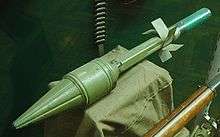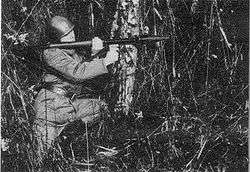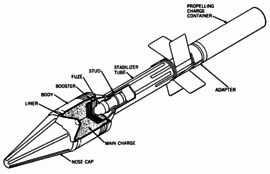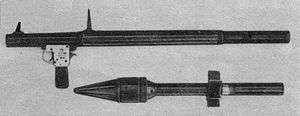RPG-2
| RPG-2 | |
|---|---|
|
RPG-2 antitank grenade launcher with PG-2 grenade | |
| Type | Rocket-propelled grenade launcher[1] |
| Place of origin | Soviet Union |
| Service history | |
| In service | 1949–1960 (Soviet Union) |
| Used by | See Users |
| Wars |
Vietnam War Laotian Civil War Cambodian Civil War Rhodesian Bush War Cambodian-Vietnamese War Sino-Vietnamese War Thai–Laotian Border War Somali Civil War Yugoslav Wars 2008 Cambodian-Thai stand-off 2010–12 Burma border clashes Libyan Civil War Syrian Civil War |
| Production history | |
| Manufacturer | State Factories |
| Variants |
M57 (Socialist Federal Republic of Yugoslavia) B-40 and B-50 (Vietnam), (Cambodia) PG-7 (Egypt) Type 56 RPG (China) |
| Specifications | |
| Weight |
2.83 kg (6.24 lb) (unarmed) 4.67 kg (10.30 lb) (ready to fire) |
| Length | 1,200 mm (47.2 in) |
| Crew |
2 including: Grenadier (carries the launcher with three grenades in special backpack) Assistant (armed with assault rifle and carries three more grenades) |
|
| |
| Shell | PG-2 HEAT round |
| Caliber |
40 mm barrel 82mm warhead |
| Rate of fire | 3–4 rounds per minute |
| Effective firing range | 100–150 m |
| Maximum firing range | 200 m |
The RPG-2 (Russian: РПГ-2, Ручной противотанковый гранатомёт, Ruchnoy Protivotankovy Granatomyot; English: "hand-held antitank grenade launcher") was a man-portable, shoulder-fired anti-tank weapon designed in the Soviet Union. It was the first successful anti-tank weapon of its type, a response to the earlier and unsuccessful RPG-1. The RPG-2 offered better range and armor penetration, making it useful against late and post-World War II tanks where the RPG-1 was of marginal use. The basic design and layout was further upgraded to produce the ubiquitous RPG-7.
History
Studying German and US anti-tank rocket designs, in 1944 the Soviets began development of the RPG-1 with the goal of combining the best features of the German Panzerfaust with the US Bazooka. Propelled by a 30 mm cartridge, the 70 millimetres (2.8 in) HEAT round could penetrate about 150 millimetres (5.9 in) of homogeneous armor.[2]
Early testing displayed a number of minor problems, but by the time these were being solved the 150 mm of penetration was considered to no longer be effective against modern tanks, even late-war designs like the Panther. The warhead was already straining the capabilities of the cartridge and its range was already considered too low.[2] Modifications to improve this began, but in 1947 the RPG-2 program started as a parallel project. Development of the RPG-2 was carried out by the GSKB-30 design bureau, originally part of the Commissariat for Munitions, but in the post-war period handed to the Ministry of Agriculture to help design farm equipment.[3]
The main difference in performance between the two were due to size. The RPG-2 used a custom designed 40 millimetres (1.6 in) cartridge to provide much greater power, and the warhead enlarged to 80 millimetres (3.1 in). This improved penetration to 180 millimetres (7.1 in) which allowed it to penetrate the frontal armor of all but very heaviest tanks, and the side and rear armor of any tank. The larger cartridge gave the PG-2 warhead slightly better practical range as well, about 150 metres (490 ft) against stationary targets.[3]
The design of the PG-2 was considerably different than the PG-1 of the RPG-1. The rear section of the PG-1 consisted of a central tube holding the propelling charge, and a second tube around this carrying the fins. When the round was inserted in the launcher, the second tube was outside the launcher tube, requiring the front of the launcher to be free of any fittings. The PG-2 replaced the fins with small metal leafs attached to the inner tube, and eliminated the outer tube found on the PG-1. This allowed the entire propellant section to be inserted in the launcher, which in turn allowed the sights and trigger assembly to be mounted right at the front of the launcher. This slightly reduced the length compared to the RPG-1, made the entire assembly more robust, and allowed the use of conventional fore-and-aft sights.[3]
The new design was such an improvement on the earlier design that development of the RPG-1 ended in 1948. The first production versions of the RPG-2 entered service with the Soviet Army's infantry squads in 1949. Although the RPG-2 could be operated by one man, standard military practice called for a two-man crew: a grenadier carrying the launcher and a purpose-built backpack containing three grenades and an assistant armed with a rifle and carrying another three-grenade backpack.[3]
In 1957 the launcher was adapted to be able to mount the NSP-2 infrared (IR) night-sight system, which consisted of an IR spotlight and a detector, together weighing (with batteries) 6 kilograms (13 lb). The NSP-2 was usable to 150 to 200 metres (490–660 ft) under good conditions. When fitted with the NSP-2, the launcher became known as the RPG-2N.[4]
Widely distributed to allies of the Soviet Union, it was also produced under license by other countries, including China and North Vietnam. Widely used against the U.S. military in the Vietnam War, its Vietnamese variants were called the B-40 (bazooka 40mm) and B-50.

Description

The RPG-2 anti tank grenade launcher is a simple 40 millimeter steel tube into which the PG-2 grenade is fitted. The tailboom of the grenade inserts into the launcher. The diameter of the PG-2 warhead is 80mm. The center section of the tube has a thin wooden covering to protect the user from the heat generated by the grenade launch. The wooden covering also makes using the weapon in extreme cold conditions easier.

The total length of the weapon with a grenade fitted was 120 centimeters (47 inches) and it weighed 4.48 kilograms (9.8 pounds). Only a simple iron sight was provided for aiming.
Only one type of grenade, the PG-2 HEAT (High Explosive Anti-Tank), was used in the RPG-2. The propellant, consisting of granulated powder was in a rolled cardboard case treated with wax that had to be attached to the grenade before loading. Once attached to the propellant charge the grenade was inserted into the smooth-bore launcher from the front. A tab on the body of the grenade indexes in a notch cut in the tube so that the primer in the propelling charge aligns with the firing pin and hammer mechanism.

To fire the RPG-2 the grenadier cocked an external hammer with his thumb, aimed, and pulled the trigger to fire. Upon launch six stabilizer fins unfolded from the grenade.
The weapon was accurate, depending on the soldiers experience, against stationary targets up to 150 meters and against moving targets at ranges of less than 100 meters. It had a muzzle velocity of 84 meters per second and could penetrate armor of up to 180 millimeters (7.17 inches) in thickness.
Users
-
 Cambodia[5]
Cambodia[5] -
 China: copied by the People's Liberation Army (PLA) as the Type 56 RPG; replaced by the newer Type 69 RPG.
China: copied by the People's Liberation Army (PLA) as the Type 56 RPG; replaced by the newer Type 69 RPG. -
 Egypt
Egypt -
 East Germany
East Germany -
 Hungary[6]
Hungary[6] -
 Laos
Laos -
 Libya
Libya -
 Macedonia
Macedonia -
 Mongolia
Mongolia -
 Myanmar
Myanmar -
 North Korea
North Korea -
 Poland
Poland -
 Moro National Liberation Front
Moro National Liberation Front -
 Rhodesia[7]
Rhodesia[7] -
 Romania
Romania -
 Somalia
Somalia -
 Somaliland
Somaliland -
 Soviet Union
Soviet Union -
 Syria[8]
Syria[8] -
 Thailand: used in small numbers, mainly by Thahan Phran.
Thailand: used in small numbers, mainly by Thahan Phran. -
 Vietnam[9] Designated as the B-40 in North Vietnamese service.
Vietnam[9] Designated as the B-40 in North Vietnamese service. -
 Yugoslavia
Yugoslavia
See also
| Wikimedia Commons has media related to RPG-2. |
- Panzerfaust
- Carl Gustav recoilless rifle
- RPG-7
- Yasin RPG
- Type 69 RPG
- Bazooka
- List of Russian weaponry
References
- ↑ http://world.guns.ru/grenade/rus/rpg-2-e.html
- 1 2 Rottman 2010, p. 16.
- 1 2 3 4 Rottman 2010, p. 17.
- ↑ Rottman 2010, p. 20.
- ↑ http://www.smallarmssurvey.org/files/sas/publications/w_papers_pdf/WP/WP4_Cambodia.pdf
- ↑ Lugosi, József (2008). "Gyalogsági fegyverek 1868–2008". In Lugosi, József; Markó, György. Hazánk dicsőségére: 160 éves a Magyar Honvédség. Budapest: Zrínyi Kiadó. p. 389. ISBN 978-963-327-461-3.
- ↑ Anthony Trethowan. Delta Scout: Ground Coverage operator (2008 ed.). 30deg South Publishers. p. 185. ISBN 978-1-920143-21-3.
- ↑ https://www.youtube.com/watch?v=W_2DpS1X41w
- ↑ McNab, Chris (2002). 20th Century Military Uniforms (2nd ed.). Kent: Grange Books. ISBN 1-84013-476-3.
